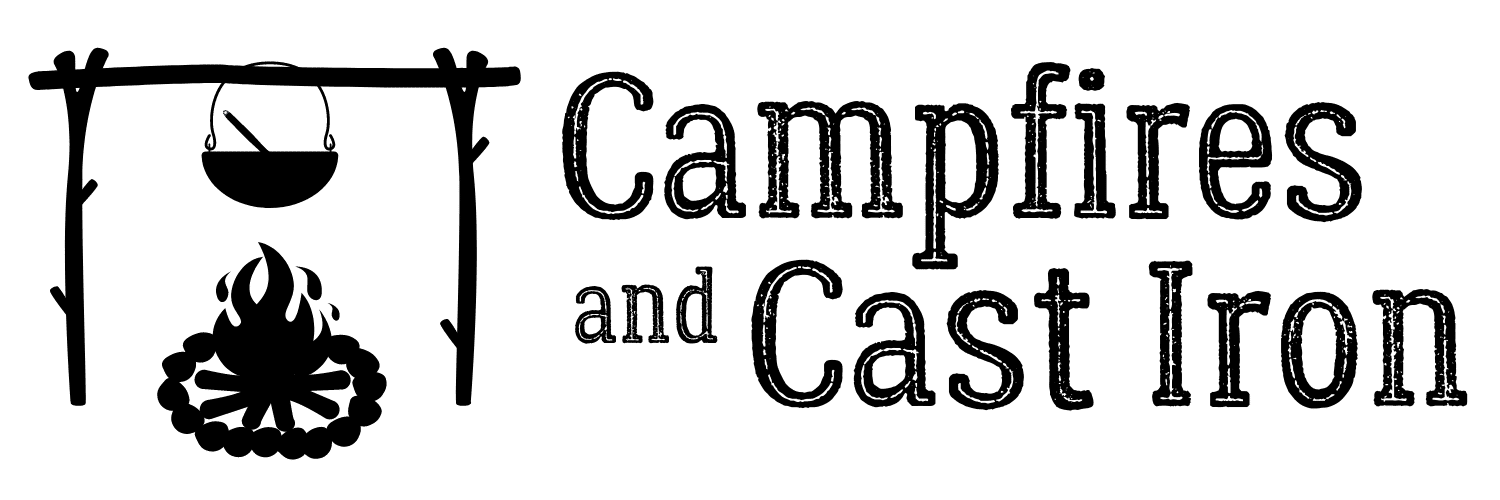Last updated on May 6th, 2022
Cooking over the campfire is a fun and traditional way to prepare meals while camping. However, cleaning stubborn campfire soot off of cast iron skillets and dutch ovens can be a real chore. I had always wondered if there was an easier way to remove the soot, and it turns out there is!
The easiest way to remove soot from cast iron cookware is with vegetable oil. Cover the dirty pan with a generous layer of oil, then use a paper towel to wipe it clean. Once the soot has been removed, use mild dish soap and a non-abrasive sponge to wash away the oily residue. Dry the pan well.
In this article, I’ll show you my favorite way to remove soot from cast iron cookware without damaging the seasoning layer. It only takes a few minutes, gets your pans completely clean, and is super easy to do while camping.
I recently cooked over the campfire with a cast iron skillet and decided to take photos of the soot-removal process to show you just how easy it is. Keep reading below to see how well it worked!
What Is Campfire Soot And Why Does It Stick To Cookware?
If you’ve ever touched a piece of cooled charcoal or firewood that didn’t completely burn, you probably got a black, powdery substance on your hands. This substance is called soot, and it is a byproduct of the incomplete combustion of wood, charcoal, or petroleum products.
Soot is primarily made up of fine particles of black carbon, which are very oily and sticky in nature. This is why your pots and pans get coated with a layer of black soot after cooking over an open fire and why it’s so difficult to remove.
How To Remove Campfire Soot From Cast Iron Cookware
For years, I struggled with removing stubborn sooty residue from my cast iron skillets and dutch ovens after using them over the campfire. I honestly hated cleaning my cookware after each camping trip because it was difficult and time-consuming. I would wash a pan two or three times, only to be frustrated when I saw persistent black residue on the towel after drying it. I just figured that was “as good as it was going to get,” and put my pan back on the shelf.
One day, as I was washing, drying, and repeating, it occurred to me that soot is fairly oily. Sometimes, using an oil-based cleaner to remove oil-based dirt is more effective than using soap. So, I decided to test my theory by cleaning my soot-covered skillet with vegetable oil. The results were nothing short of amazing! The oil removed every bit of the soot on the first try without vigorous scrubbing. After using the vegetable oil, I washed the pan with dish soap and a sponge. When I dried the pan, there were no traces of soot on the towel. I couldn’t be happier!
Here are the steps I followed to remove campfire soot from cast iron cookware:
1. Wash The Pan With Soap
First, wash the pan with mild dish soap and a non-abrasive sponge. This will remove any large dirt particles and excessive soot debris.
Now, before you say, “Wait! I thought you couldn’t use soap on cast iron!”, let me explain why it’s safe. Several decades ago, when dish soap was lye-based, the lye was strongly caustic and would essentially eat through the pan’s seasoning layer. Modern-day dish soaps are not made with lye and will not remove the seasoning layer from a properly-seasoned cast iron pan.
We’re also just focusing on cleaning the outside of the pan with the soap, not the inside. If you wish to avoid using soap on the inside cooking surface, that’s completely fine.
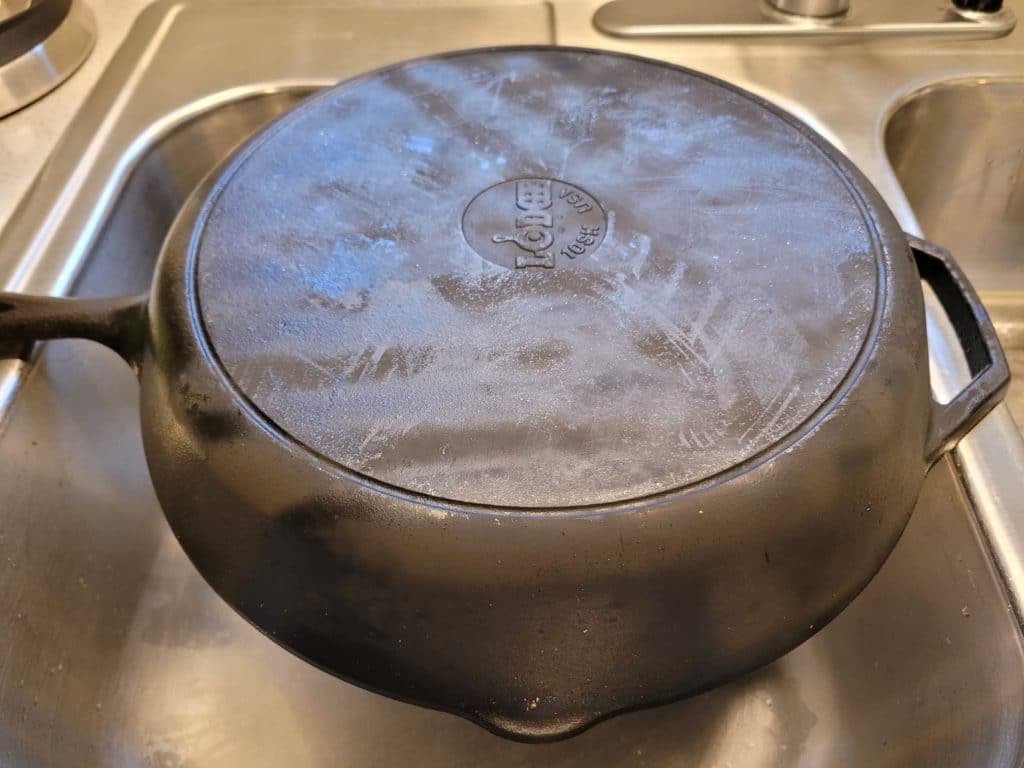

While washing the pan with dish soap is a good start, it definitely doesn’t remove all of the soot residue. Here’s what happened when I dried the pan with a paper towel after scrubbing it with soap and a sponge. You can even see some of the residual soot that rubbed off on my hand.
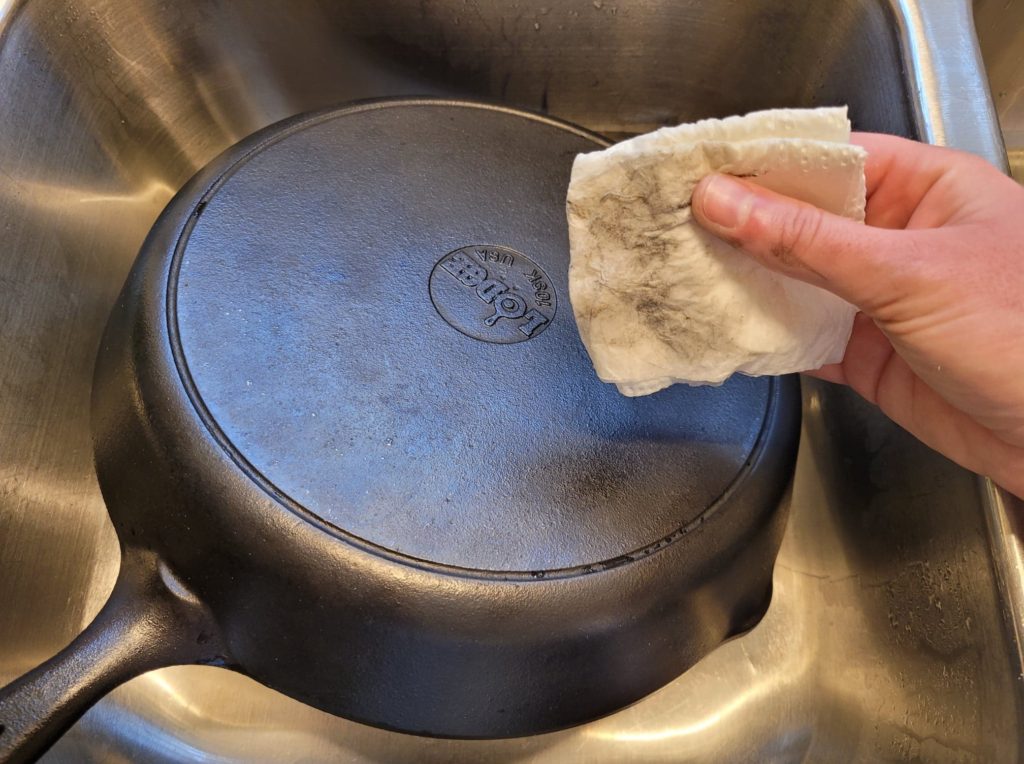
2. Dry The Pan, Then Wipe With Vegetable Oil
The next step is to dry the pan with a paper towel. Then, completely coat the outside of the pan with vegetable oil. Any cheap cooking oil will do. Use a paper towel to lightly rub the oil all over the dirty surfaces of the pan. Don’t forget the handles and crevices.
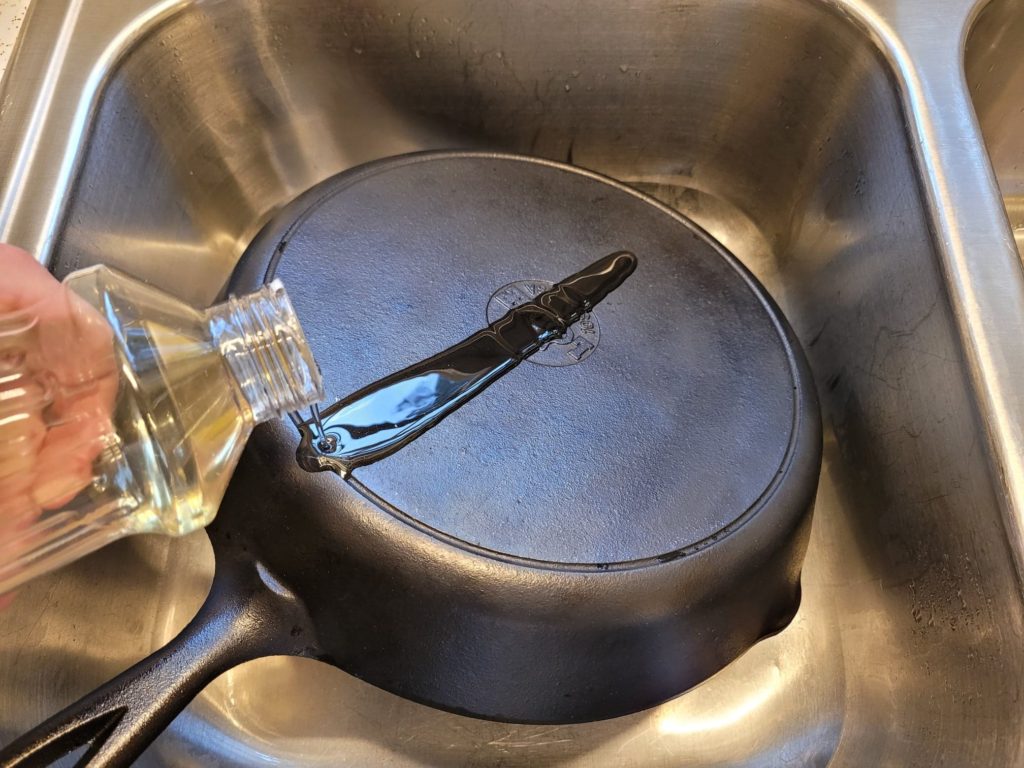
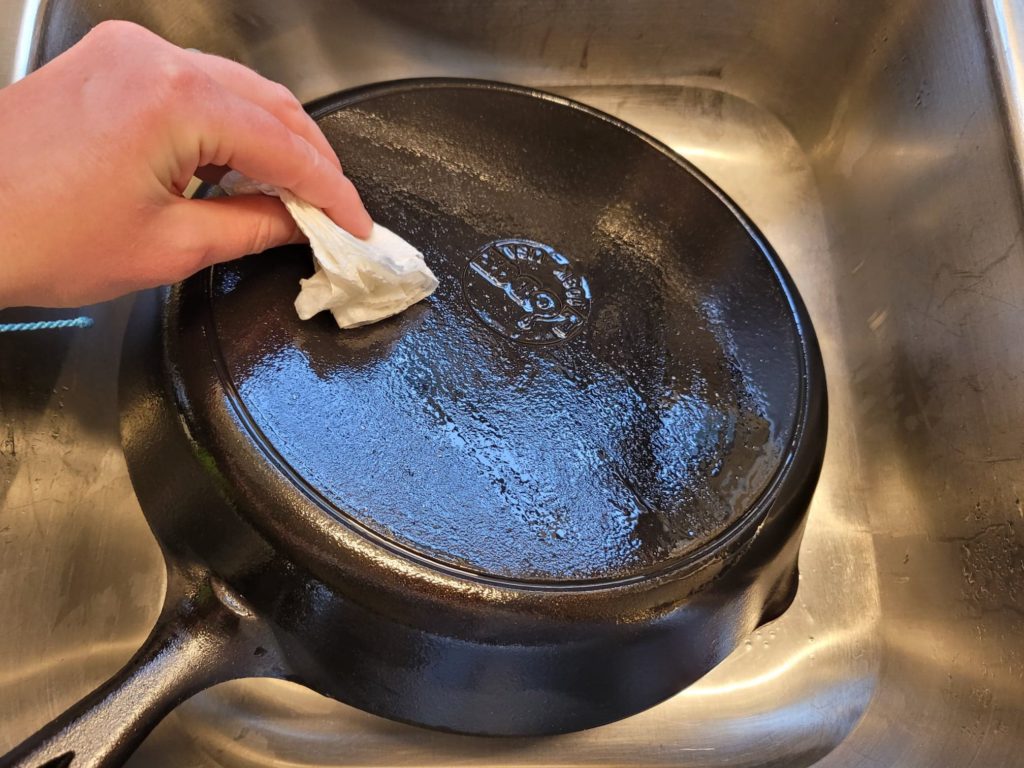
Take a look at the photo below to see how much soot was left on my skillet. This was AFTER I had already scrubbed it with soap and a sponge! I couldn’t believe how dirty it still was. As you can see, the oil did a great job of cutting through the sticky, oily soot residue.
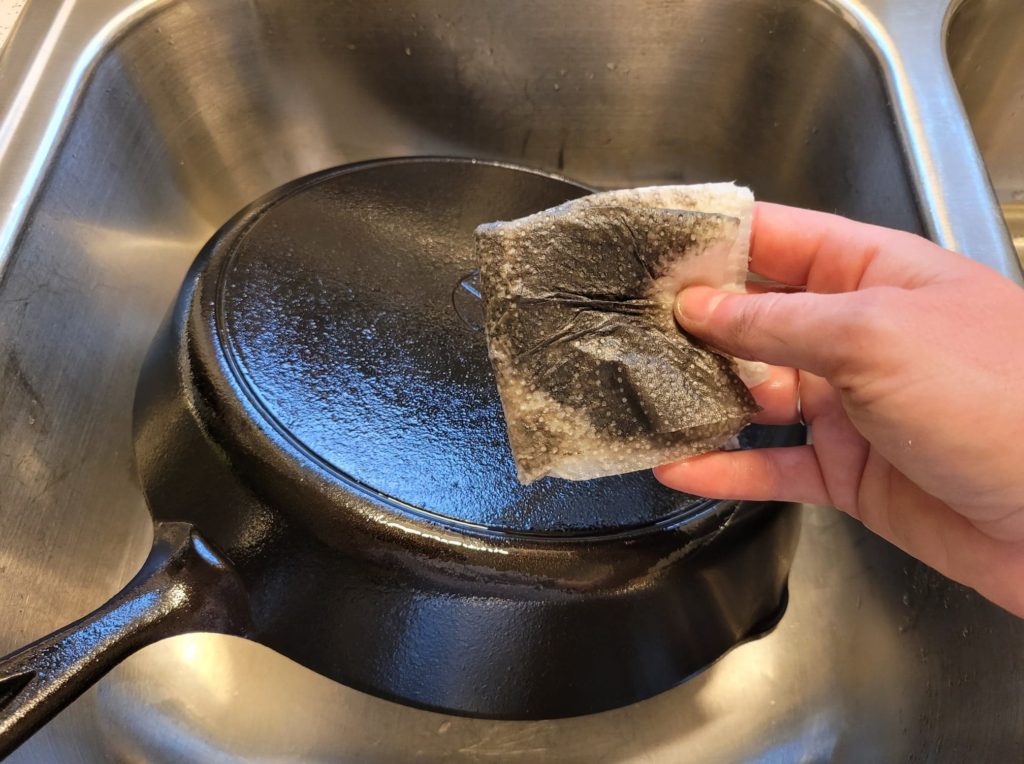
3. Wash The Pan Again
After cleaning the pan with vegetable oil, wash it again with soap to remove the oily residue. Rinse the pan well, then dry it thoroughly. I dried mine with a paper towel to make sure all the soot had been removed, and here are the results:

I was quite pleased to see that the paper towel was completely clean. No traces of soot were left behind and the outside of my cast iron pan didn’t feel sticky or oily. This time, when I put my skillet away, I was sure that it was actually clean and soot-free.
Conclusion
I’m so glad I found a much easier way to fully remove campfire soot from cast iron cookware. I’m confident this will be my go-to method for cleaning my skillets and dutch ovens after camping. If you decide to try cleaning your cookware with oil, leave me a comment and let me know your results!
For more information on caring for your cast iron, check out my other popular articles:
How To Clean And Sanitize Cast Iron Cookware While Camping.
Seasoning Cast Iron Cookware: A Step-By-Step Guide
How To Pack And Store Cast Iron Cookware For Camping
Looking for camp cooking inspiration? Be sure to check out the Recipes section of the blog for a great selection of delicious and easy camping recipes!
This post may contain affiliate links. This means if you click on a link and make a purchase, I will receive a small commission, at no cost to you, that makes it possible for me to keep the Campfires and Cast Iron site up and running. Please see our disclosure policy for details.
